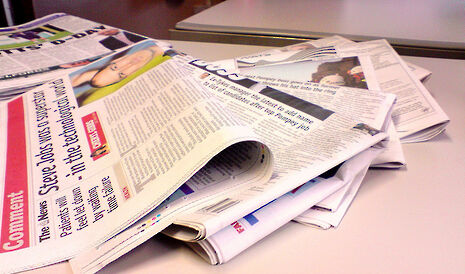Printed newspapers are things of real beauty
Online media is important, but there’s something about paper and ink that can’t be replaced

This newspaper in your hands is a funny thing, isn’t it? Cumbersome, noisy sheets of paper. Of course, you might be reading this article online – a browser tab open in place of the essay you’ve been procrastinating over for hours, or maybe a hurried glance at your phone as you wait for the kettle to boil. Whatever. Humour me, for the time being, as we discuss the concept of the printed newspaper.
As you may have gathered from this somewhat special edition, this is the 800th Varsity, and it’s interesting to note that the newspaper continues to be published today in a printed form. When Varsity first began, there was little choice for news-sharing platforms. Without the internet (*gasp*), a wodge of paper, collectable from the nearest plodge, was the most effective means to communicate news to the wider Cambridge student public.
However, today the situation is obviously very different. Twitter, Facebook and even YikYak are far quicker ways to tell several thousand people about an event or a scandal, or to share a personal opinion. Varsity has adapted to this with a website and assorted social media accounts that allow it to interact with news as it happens.
And yet, we still insist upon printing this as a newspaper each Friday. While Cambridge is a place filled with tradition for tradition’s sake, the 10,000 copies of Varsity distributed weekly point to something larger than an archaic heritage we haven’t the heart to scrap (not to mention an environmentally-unsound use of paper), and instead suggest that there is still a demand for the printed.
Part of the appeal, for me at least, is the commitment which the material newspaper signifies: the very real effort of remembering to pick it up, carrying it home, protecting from the rain, and placing it upon a table or desk where it sits, loudly demanding to be read. In grabbing a copy of the newspaper you are committing yourself to reading it in a far more obtrusive, unforgettable way than from a half-hearted Google search.
Once committed, the experience of reading the newspaper itself is something special. The paper smells the way only fresh ink does; the pages make that distinctive crackle as you turn and fold them. There is some unique charm to the physical object of the newspaper which pixels on the screen simply cannot match.
To become obscenely poetic, you could say that the act of reading the newspaper both changes it, the object, as you crease and crumple the pages in your own manner, leaving a tea stain here and a biscuit crumb there, and changes you, as you are left with those annoying ink stains on your hands. Physical beauty aside, it is undeniable that the material newspaper creates a more intimate relationship between you, the reader, and what you are reading.
There is a tendency, too, for the reading of news online to blur with other activities. Passing from newsfeed-scrolling to selfie-taking via an online newspaper hinders your ability to engage with it properly. The heartfelt political commentary, the considered review of an arty theatre production and the latest news tragedy are sets of words and images upon a screen, that can all too easily blur with the continual stream of banalities upon your phone.
The printed newspaper offers a solution to this as its medium is rather unique. The book, perhaps, comes closest, suggesting our engagement ought to be serious, intellectual, intrusive, but ultimately enjoyable. But the newspaper’s demand that you wrestle with its inexplicably-oversized pages, balancing it precariously upon your lap so that it takes up the whole of your vision is an unmistakeable experience, a certain skill-set you could say, which forces a distinctive ‘newspaper’ mentality of engagement.
Exactly what constitutes this ‘newspaper’ mentality is difficult to define. It is, in part, an openness, as you turn the pages to see what catches your eye. You are not chasing labelled online links to articles you know will interest you, but rather ambling through the newspaper to see what sparks your attention. This might be an interview with a Nobel Prize-winning scientist; or it may be ‘The Secret Diary of Katrina Kettlewell’ (I’m not judging your preferences here).
While there is a very obvious place in the modern world for the online newspaper as providing authoritative information and high-quality journalism, as well as reacting real-time to events as they happen, I’m a strong believer that there’s still a need for the printed newspaper to exist alongside its digital counterpart. The visceral nature of a physical copy of Varsity – the weight, the noise, the smell – make for a unique reading experience irreplaceable by any digital media.
 Features / How sweet is the en-suite deal?13 January 2026
Features / How sweet is the en-suite deal?13 January 2026 Comment / Will the town and gown divide ever truly be resolved?12 January 2026
Comment / Will the town and gown divide ever truly be resolved?12 January 2026 News / 20 vet organisations sign letter backing Cam vet course13 January 2026
News / 20 vet organisations sign letter backing Cam vet course13 January 2026 Arts / Fact-checking R.F. Kuang’s Katabasis13 January 2026
Arts / Fact-checking R.F. Kuang’s Katabasis13 January 2026 Music / Inside Radiohead’s circle13 January 2026
Music / Inside Radiohead’s circle13 January 2026









